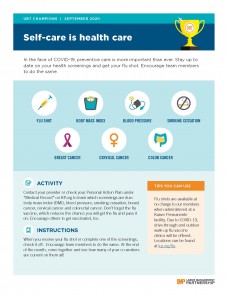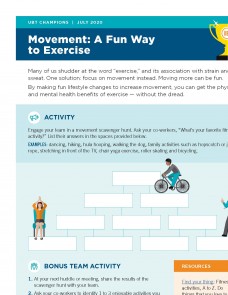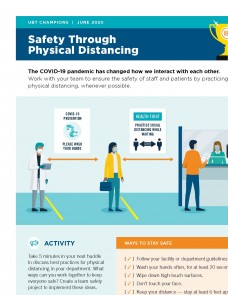TOOLS
TOOLS
TOOLS
(plain node.html.twig - needs theming)
( still node.html.twig ... )
- Training staff how to identify patients overdue for breast cancer screenings
- Partnering with Imaging department staff to fast-track mammogram appointments for pharmacy patients
- Developing a script to encourage patients to get preventive health screenings
What can your team do to work with other departments on a shared goal?
( end node.html.twig ... )
Quality
Tips for Improving Health Screenings
Deck
Identifying health risks is essential to Kaiser Permanente's mission
Screenings for such diseases as colorectal and breast cancers, high blood pressure, diabetes and obesity help us proactively identify identifying health risks and early signs of disease Here are some ways everyone can help ensure our members stay as healthy as possible.
- During a visit, print out and review with the patient any screening gaps that are identified on his or her Proactive Office Visit summary.
- Use KP HealthConnect™ and/or panel management tools to identify and reach out to members who are due for a screening to check for high blood pressure or such diseases as colorectal or breast cancer.
- Have receptionists keep an eye out for age- and risk-appropriate members during office visits and target them for follow up by care providers.
- Create outreach scripting that personalizes the importance of preventive screenings.
- Designate a staff member to contact members who received at-home fecal immunochemical tests (known as FIT kits), to remind them to return them.
- Capture patients’ attention by posting or mailing brightly colored literature that explains how a test detects early signs of disease and can be life-saving.
- Work with your local radiology department to identify the best days and times for same-day mammograms, so patients can get the scan without an appointment.
- Contact hypertensive patients at pharmacy pick-up counters for blood pressure checks and consultations.
- Have clinical assistants and/or medical assistants increase the number of outreach calls and blood pressure checks.
- Invite a regional or local expert in prevention and screening to meet with your team to discuss how best to support regional and local initiatives without duplicating efforts.
Quality
Tips for Flu Prevention
Deck
How to protect yourself and our members from this virus
When flu season arrives, it’s important to stay well. As a matter of patient and workplace safety and professional pride, we can take steps to protect ourselves, our families, co-workers, and members and patients from flu and other infectious diseases. Here’s how.
Vaccinate yourself and others
- If you don’t get the flu, you won’t pass it on. The vaccine reduces the chance you will get the flu. Encourage others to get vaccinated, too.
Keep flu out of the air
- Limit the time patients with suspected flu spend in open waiting rooms; separate them from others.
- Offer surgical masks to people who are coughing or sneezing and encourage them to cover their coughs. Supply tissues, trash cans and hand sanitizer in waiting areas.
- Place patients with flu in a private room.
- Avoid unnecessary transport of infectious patients — and have them wear surgical masks outside their rooms.
Keep flu off of yourself. Follow standard and droplet precautions
- Wear eye protection, gown and gloves.
- Wear respiratory protection when in the room with the patient and until the air has cleared after the patient has left the room (about one hour), or if you are doing procedures that may aerosolize infectious particles.
- Wash your hands often. Use hand sanitizer or wash with soap and water before and after all patient care.
- Avoid touching your face, clothing or mask with your hands.
Keep the environment clean
- Focus cleaning on high-contact surfaces: door knobs, elevator buttons, reception desks, exam tables, pharmacy furniture.
(plain node.html.twig - needs theming)
( still node.html.twig ... )
- Using key phrases in malnutrition assessment to catch the attention of physicians
- Bolding their recommendations in notes to doctors
- Speaking directly to physicians about potentially malnourished patients
What can your team do to improve cooperation between physicians and other members of the care team?
( end node.html.twig ... )
(plain node.html.twig - needs theming)
( still node.html.twig ... )
- Identifying persistent asthmatics, instead of waiting to follow up on ER visits
- Discussing with patients and parents how to avoid flare-ups
- Educating about the proper use of their medication to control the disease
What can your team do to harness KP's unique tools to enhance preventive care? And what can your team do to help patients better understand their care?
( end node.html.twig ... )
(plain node.html.twig - needs theming)
( still node.html.twig ... )
- Reporting weekly on staff engagement with patients
- Training and peer-to-peer coaching of staff
- Educating physicians on awareness
What can your team do to leverage KP's unique tools for prevention to keep patients healthy?




